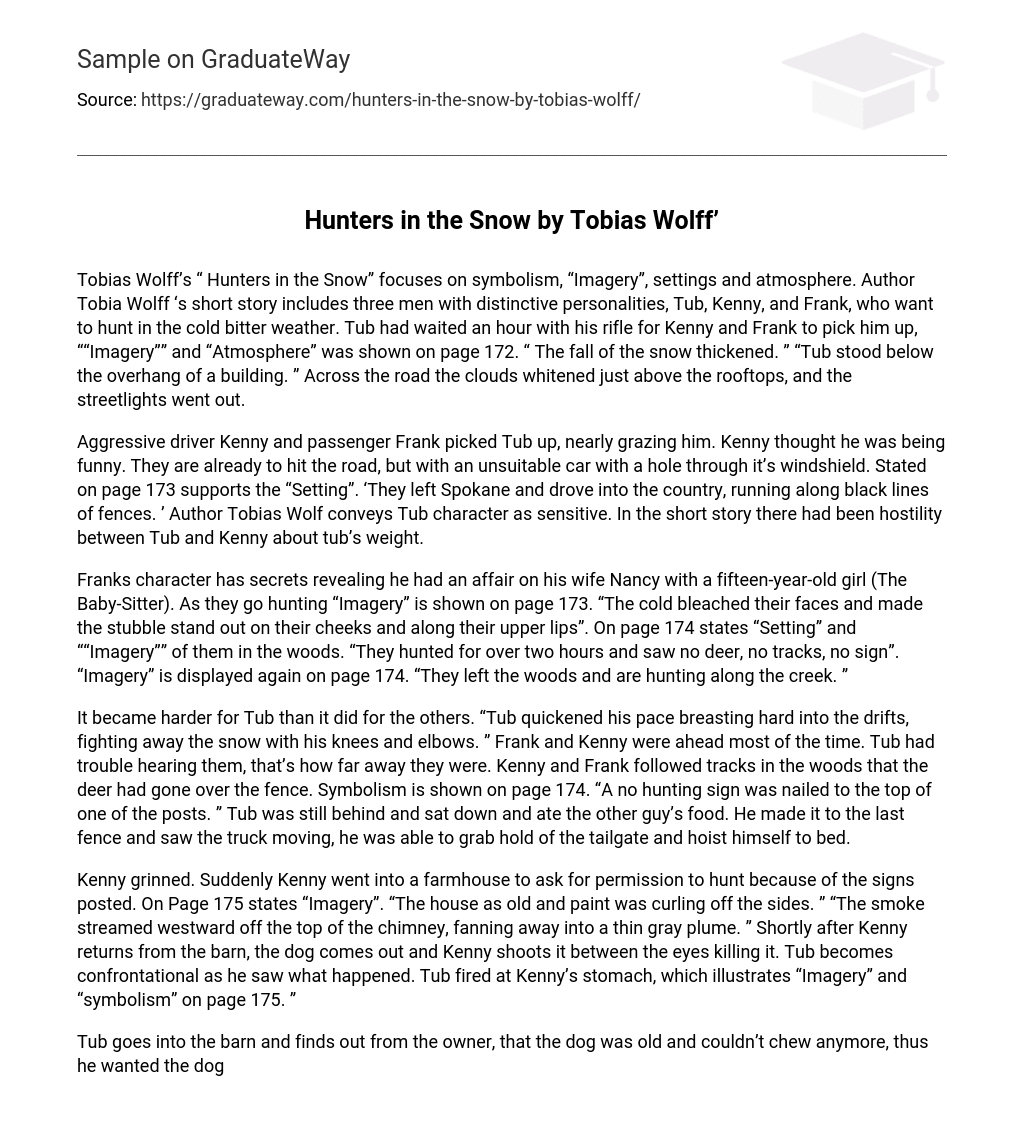Tobias Wolff’s short story “Hunters in the Snow” explores symbolism, imagery, settings, and atmosphere. The narrative revolves around three characters, Tub, Kenny, and Frank, each with their own distinct personalities, who set out to hunt in harsh winter conditions. Tub finds himself waiting for an hour with his rifle, anxiously anticipating the arrival of Kenny and Frank (as demonstrated on page 172). The author uses imagery to depict the worsening weather, stating that “the fall of the snow thickened” and describing Tub’s position below a building’s overhang. Meanwhile, across the road, the rooftops grew white and the streetlights ceased to illuminate.
Kenny, an aggressive driver, and his passenger Frank picked up Tub in a reckless manner, almost hitting him. Kenny believed he was being humorous. They were ready to start their journey but had a car that was not suitable, as it had a hole in its windshield. The information on page 173 highlights the importance of the “Setting” in the story. According to author Tobias Wolf, Tub’s character is portrayed as sensitive. Throughout the short story, there was animosity between Tub and Kenny regarding Tub’s weight.
Frank’s character is shown to have secrets as it is revealed that he had an affair on his wife Nancy with a fifteen-year-old girl, referred to as “The Baby-Sitter”. The narrative uses imagery to describe their hunting experience, with one instance on page 173 where it is stated that “the cold bleached their faces and made the stubble stand out on their cheeks and along their upper lips”. The setting and imagery of the characters in the woods are mentioned on page 174, where it is noted that they hunted for over two hours without any success in finding deer, tracks, or signs. The use of imagery is once again highlighted on the same page, with the mention of them leaving the woods and continuing their hunt along the creek.
It became more challenging for Tub compared to the others. “Tub hastened his pace, clearing the snow with his knees and elbows.” Frank and Kenny were constantly in the lead. Tub struggled to hear them as they were situated far ahead. Kenny and Frank followed the tracks of deer that had crossed the fence into the woods. The symbolism is portrayed on page 174, where “a no hunting sign was attached to one of the posts.” Tub remained behind and decided to eat the food belonging to the other individuals. Finally, he reached the last fence and spotted the moving truck. He managed to grip onto the tailgate and pull himself onto the bed.
Kenny grinned as he entered a farmhouse to seek permission for hunting, prompted by the signs posted. On Page 175, it describes the house: “The house was old and paint was curling off the sides.” Additionally, the description continues, “The smoke streamed westward off the top of the chimney, fanning away into a thin gray plume.” Soon after Kenny’s return from the barn, the dog emerges and Kenny shoots it, instantly ending its life with a shot between the eyes. Witnessing this, Tub becomes confrontational. Tub responds by firing at Kenny’s stomach, which serves as an example of “Imagery” and “symbolism” on page 175.
Tub enters the barn and discovers from the owner that the dog was elderly and unable to chew. Consequently, the owner wished to end the dog’s suffering. However, he couldn’t bring himself to shoot his own dog, even if he had a gun. Meanwhile, Kenny persists in his plea to go to the hospital due to his severe bleeding in the truck. Despite Kenny’s urgent need for medical attention, his friends decide to keep warm and have a meal at the Tavern until they are full. The denouement of this narrative is startling, containing vivid descriptions on page 182. “I’m going to the hospital,” Kenny stated. Yet, he was mistaken. They had taken a different route quite a while ago.





